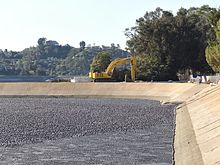Shade balls

Covering a water surface with shade balls is a method of protecting open drinking water reservoirs from harmful effects of the sun (e.g. evaporation) with the help of floating plastic balls. A project in California that was completed in the summer of 2015 saw large-scale use of shade balls when 96 million balls were placed in a drinking water reservoir.
A water cover with balls outside the drinking water protection comes z. B. on water surfaces in the vicinity of airports to keep birds away and thus avoid bird strikes.
Material and manufacture
The balls of the Californian project have a diameter of 10 cm and are black. They are made of environmentally neutral polyethylene , are hollow and filled with water and are therefore heavy enough that they are not blown by the wind, but they are buoyant. They are hermetically sealed; at the same time the water contained is of drinking water quality itself . They are provided with a UV- repellent coating, which should also ensure durability. The material of the balls is subject to drinking water regulations.
The balls were produced by a startup company, the unit price is 36 dollar cents , the total cost is 34.5 million US dollars. The savings compared to an alternative type of cover are stated to be US $ 250 million. A service life of the shade balls of 25 years is envisaged.
Protective effect
The balls were brought into the Los Angeles Reservoir from 2012 to mid-2015 in the largest project of this type to date, the surface of which is covered with them and thus shielded from solar radiation. The reservoir is the largest drinking water reservoir of its kind operated by the Los Angeles Department of Water and Power. It has a capacity of 12.5 million cubic meters, which is sufficient to supply Los Angeles for up to three weeks. In previous projects from 2008 onwards, the Shade Ball Cover concept already proved to be "100% effective".
The reason for the distribution of these balls was the guarantee of the drinking water quality. Chlorine is added to the drinking water reservoir to prevent and disinfect algae formation ( chlorination # water treatment ). According to the drinking water supplier , this chlorine, together with sunlight, oxidizes the existing bromide to bromate , which is considered to be carcinogenic. It is subject to limit values in drinking water that would be exceeded without the balls. The balls effectively block out sunlight. At the same time, the chlorination can be reduced as there is less algae formation.
A reduction in evaporation is not a planned, but a useful side effect. A representative of the drinking water supply explains that the savings from lower evaporation and lower chlorination are half the cost of the balls. The improvement in water quality, however, is of immeasurable value.
Evaporation could be reduced by 85 to 90% on a total area of 708,200 m², thus saving over a million cubic meters of water per year. California struggled with drought and drinking water shortages from 2011 to 2017 .
Web links
- Los Angeles Reservoir - Shade Ball Cover - Fact Sheet
- http://www.bloomberg.com/news/articles/2015-08-11/who-s-behind-the-96-million-shade-balls-they-just-rolled-into-las-reservoirs-
- http://www.spiegel.de/wissenschaft/natur/duerre-in-kalifornia-baelle-im-see-sollen-trinkwasser-schuetzen-a-1047801.html
- http://www.ladwpnews.com/go/doc/1475/2578586/MAYOR-GARCETTI-ANNOUNCES-COMPLETION-OF-INNOVATIVE-SHADE-BALL-COVER-PROJECT-AT-LOS-ANGELES-RESERVOIR
Individual evidence
- ↑ Why Are 96,000,000 Black Balls on This Reservoir? Youtube video (English) after 3:00 . Retrieved in 20190818.
Coordinates: 34 ° 6 '14.3 " N , 118 ° 15' 58.7" W.